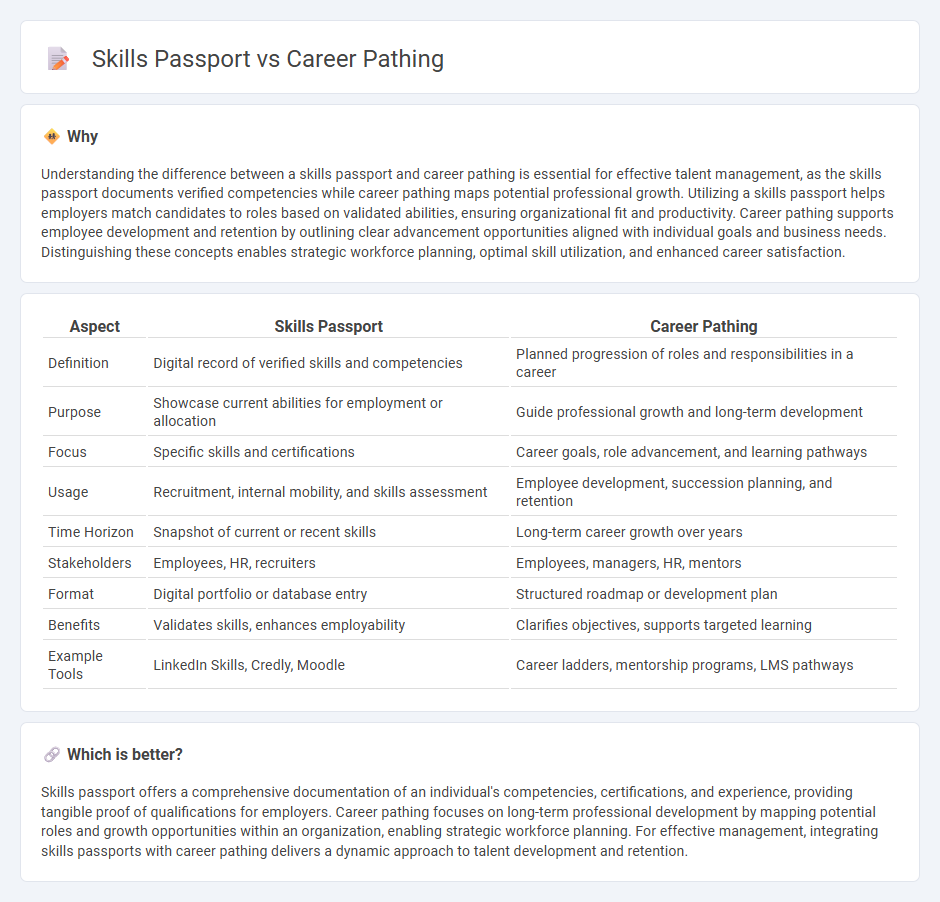
Management skills passports provide a detailed record of an individual's competencies and professional achievements, facilitating targeted development and talent mobility within organizations. Career pathing offers a strategic framework for employees to visualize and plan their progression, aligning personal goals with organizational objectives. Explore further to understand how integrating skills passports with career pathing enhances workforce development and retention.
Why it is important
Understanding the difference between a skills passport and career pathing is essential for effective talent management, as the skills passport documents verified competencies while career pathing maps potential professional growth. Utilizing a skills passport helps employers match candidates to roles based on validated abilities, ensuring organizational fit and productivity. Career pathing supports employee development and retention by outlining clear advancement opportunities aligned with individual goals and business needs. Distinguishing these concepts enables strategic workforce planning, optimal skill utilization, and enhanced career satisfaction.
Comparison Table
| Aspect | Skills Passport | Career Pathing |
|---|---|---|
| Definition | Digital record of verified skills and competencies | Planned progression of roles and responsibilities in a career |
| Purpose | Showcase current abilities for employment or allocation | Guide professional growth and long-term development |
| Focus | Specific skills and certifications | Career goals, role advancement, and learning pathways |
| Usage | Recruitment, internal mobility, and skills assessment | Employee development, succession planning, and retention |
| Time Horizon | Snapshot of current or recent skills | Long-term career growth over years |
| Stakeholders | Employees, HR, recruiters | Employees, managers, HR, mentors |
| Format | Digital portfolio or database entry | Structured roadmap or development plan |
| Benefits | Validates skills, enhances employability | Clarifies objectives, supports targeted learning |
| Example Tools | LinkedIn Skills, Credly, Moodle | Career ladders, mentorship programs, LMS pathways |
Which is better?
Skills passport offers a comprehensive documentation of an individual's competencies, certifications, and experience, providing tangible proof of qualifications for employers. Career pathing focuses on long-term professional development by mapping potential roles and growth opportunities within an organization, enabling strategic workforce planning. For effective management, integrating skills passports with career pathing delivers a dynamic approach to talent development and retention.
Connection
A skills passport systematically documents an employee's competencies and qualifications, providing a clear overview for effective career pathing within an organization. Career pathing leverages this detailed skills inventory to identify growth opportunities, tailor development plans, and align employee capabilities with strategic business goals. Integrating a skills passport streamlines talent management by enabling data-driven decisions that foster continuous skill enhancement and career progression.
Key Terms
Career Pathing:
Career pathing is a strategic approach that maps an employee's growth within an organization by identifying roles, skills, and experiences needed to advance. It emphasizes personalized development plans and aligns talent development with business goals to boost retention and engagement. Explore how career pathing can transform your workforce development strategies for long-term success.
Progression Mapping
Career pathing emphasizes progression mapping by outlining clear job roles, required skills, and milestones for employee advancement within an organization. Skills passports document an individual's competencies, certifications, and learning achievements, providing a portable portfolio to support internal mobility and external opportunities. Explore how integrating progression mapping with skills passports can enhance talent development and career growth strategies.
Role Milestones
Role milestones in career pathing emphasize clear progression steps within a job function, aligning personal growth with organizational goals through defined competencies and achievements. Skills passports document accumulated skills and experiences across various roles, providing a comprehensive record that supports mobility and continuous learning. Explore how integrating role milestones and skills passports can enhance talent development strategies.
Source and External Links
What Is Career Pathing & Why Is It Important? - Career pathing is a process used by employers to create a development plan that aligns employees' skills, interests, and opportunities with their career goals.
Career Pathing: The Complete Guide - This guide introduces two main approaches to career pathing: the traditional career ladder and the more flexible career lattice.
Improve Employee Development with Career Pathing - Career pathing involves mapping out an employee's potential career trajectory within a company, typically through self-assessment, individualized career mapping, and exploring opportunities.
 dowidth.com
dowidth.com